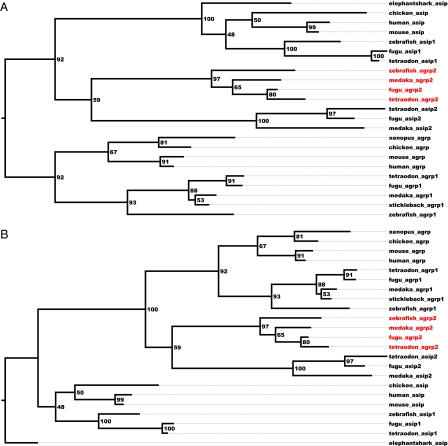Tetrapods express one agouti gene [agouti signaling protein (asip)] in the skin regulating pigmentation and a second [agouti-related protein (agrp)] in the brain regulating energy homeostasis. In contrast, most teleosts have four genes encoding agouti-type proteins. Braasch and Postlethwait (1) present an analysis of the evolutionary history of agouti genes in teleosts, reordering the phylogenetic tree proposed previously (2) and proposing a nomenclature change. However, gene nomenclature derives mainly from functional or sequence properties and not from evolutionary predictions. Furthermore, inclusion of an ancient agouti sequence from the elephant shark provides an additional interpretation of the phylogeny (Fig. 1).
Fig. 1.
Phylogeny of the agouti gene family members. The full-length sequences from Braasch and Postlethwait (1) were aligned (except sequences where the reference was to unspecified Contig regions) using MAFFT-EINSI 6.624b with default settings and 10 rebuilds. RAxML-III was used with the fast and easy settings: bootstrap maximum likelihood, Whelan and Goldman (WAG) model, estimate proportion of invariable sites, empirical base frequencies, and 100 bootstraps using easyrax.pl as interface. (A) This dendrogram is rooted on the agrp clusters. (B) This dendrogram is equivalent to A but rerooted on the elephant shark full-length sequence (Callorhinchus milii). The difference is that now the A2 cluster, containing the agrp2 and asip2 sequences, is grouped with the agrp cluster instead of the asip cluster. Bipartitions trees were viewed in Fig Tree 1.3.1 (http://tree.bio.ed.ac.uk/software/figtree/).
The word agouti, from the Guaraní language of South America, refers to rodents (genus: Dasyprocta) noted for prominent-banded pigment patterns in individual hair shafts. The term agouti came to be used to describe mutations in tetrapods that impacted this banding pattern. The agrp gene, discovered later, encodes a protein in hypothalamic neurons, and zebrafish agrp shares the same distribution of expression, regulatory properties, and function with the mammalian protein of the same name. More recently, we showed that a zebrafish gene called agrp2, a teleost-specific agouti family member expressed in the pineal, controls expression of hypothalamic melanin-concentrating hormone genes (pmch and pmchl) and regulates background adaptation (3).
In teleosts, an ancient duplication produced four agouti genes. asip2 and agrp2 (4) were initially called A2 genes, and their cysteine motifs start with C6C5CC… rather than C6C6CC… found in both agrp and asip. The analysis by phylogeny and synteny of teleost agouti genes (2) suggested that agrp and agrp2 shared synteny with mammalian agrp and were paralogous genes derived from the teleost genome duplication. After the analysis of Braasch and Postlethwait (1), it seems unlikely that agrp2 came from agrp and asip2 came from asip, and it seems that the A2 genes could have a common origin. Why did Kurokawa et al. (2) suggest the original nomenclature? It seems that synteny analysis by Kurokawa et al. (2) was not based on the current scaffolds for Takifugu rubripes but an older version that has changed as the scaffolds improved.
We (H.B.S. and Å.V.) performed a phylogenetic analysis using Braasch and Postlethwait’s (1) sequence set and included the ancient elephant shark agrp/asip-like sequence (5). This analysis suggested that agrp2s and asip2s are similar to each other (bootstrap value of 52–59% using maximum likelihood), in agreement with Braasch and Postlethwait (1). However, it is unclear from the phylogeny if the A2 cluster originated from the asip or agrp clusters. When the agrp cluster is used to root the tree (Fig. 1A), the A2 cluster groups with the asip cluster, but when the elephant shark asip is used to root the tree (Fig. 1B), the A2 cluster groups with the agrp cluster. It is, thus, doubtful that phylogenetic analysis of current sequences can determine if the A2 cluster is more similar to either asip or agrp clusters. In the meantime, according to the zebrafish nomenclature guidelines, the name that appears first in the literature should be given priority (http://zfin.org/zf_info/nomen.html).
Footnotes
The authors declare no conflict of interest.
References
- 1.Braasch I, Postlethwait JH. The teleost agouti-related protein 2 gene is an ohnolog gone missing from the tetrapod genome. Proc Natl Acad Sci USA. 2011;108:E47–E48. doi: 10.1073/pnas.1101594108. [DOI] [PMC free article] [PubMed] [Google Scholar]
- 2.Kurokawa T, Murashita K, Uji S. Characterization and tissue distribution of multiple agouti-family genes in pufferfish, Takifugu rubripes. Peptides. 2006;27:3165–3175. doi: 10.1016/j.peptides.2006.09.013. [DOI] [PubMed] [Google Scholar]
- 3.Zhang C, et al. Pineal-specific agouti protein regulates teleost background adaptation. Proc Natl Acad Sci USA. 2010;107:20164–20171. doi: 10.1073/pnas.1014941107. [DOI] [PMC free article] [PubMed] [Google Scholar]
- 4.Klovins J, Schiöth HB. Agouti-related proteins (AGRPs) and agouti-signaling peptide (ASIP) in fish and chicken. Ann N Y Acad Sci. 2005;1040:363–367. doi: 10.1196/annals.1327.063. [DOI] [PubMed] [Google Scholar]
- 5.Vastermark A, Schioth HB. The early origin of melanocortin receptors, agouti-related peptide, agouti signaling peptide, and melanocortin receptor-accessory proteins, with emphasis on pufferfishes, elephant shark, lampreys, and amphioxus. Eur J Pharmacol. 2011 doi: 10.1016/j.ejphar.2010.10.106. in press. [DOI] [PubMed] [Google Scholar]



